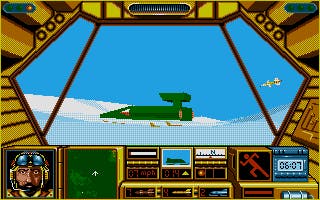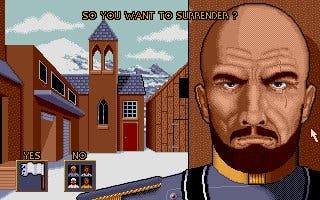Retrospective: Midwinter
Freeze a jolly good fellow.
But even this wasn't as simple as it may sound. Cue Midwinter's next brilliant idea. The people on the island weren't anonymous avatars, but distinct personalities. Recruiting people meant understanding their lives and loyalties. Family members could rally each other quite easily, but other characters would distrust or even hate each other, for various reasons. Since certain characters had differing skillsets, this was a strategic choice rather than merely narrative.
Only Professor Kristiansen could operate the radio, for example, and he'd only join up if his grandson asked him. Other characters were better snipers, or could sustain more damage. Picking the right people for the job, and working out who you needed to win over in order to earn the trust of someone else, was all part of the challenge.
It all added up to a monster of a game, vast in ways that were then unheard of, and all rendered in chunky polygon 3D. It was fast as well, a far cry from the ponderous vistas of Freescape's Driller and Castle Master. The world might not have been full of things to see, but it felt real - a solid, tangible place where trees could splatter an unwary skier, and where a sniper's hands would shake if left too long.

Most of all, it's the sheer freedom that made Midwinter such an obsession for me. This was a game with no strict guidance and no linear corridors, just wide open snow-blasted plains and an end goal that was specific in nature but wonderfully open in execution. Of course, there were certainly things you could do, and people you could recruit, in a particular order for a more efficient journey through the game, but there was no punishment for forging your own path. Like most great games, it didn't drag the player through a predetermined story but gave you the space to make one up of your own, dictated by decisions and action rather than somebody else's script.
I discovered this myself, to my lasting joy, when I decided on a whim to see if I could sneak past the enemy and attack General Masters HQ single-handed. Which I did, successfully. I have no idea how I managed that - it seems like it should have been impossible - but, somehow, it worked. You could argue that allowing the player to circumnavigate pretty much every gameplay mechanism in the game was a sign of poor design, but for 16-year-old me it was a revelation that gave me a lifelong passion for open-ended freeform game design.

Others would pick up Midwinter's baton, refining and improving on its core ideas as processors got faster and graphics became sharper. Certainly, the Fallout series owes a huge debt to Midwinter, as does The Elder Scrolls. That most of Midwinter's best ideas are still considered fairly cutting edge and are integral to most action games today is a testament to just how far Mike Singleton's team pushed the boundaries of how games could be played, using hardware that was downright primitive by 2010 standards.
And what of the snow? Clearly, the snowy setting was chosen in part because it made the gameworld simpler and therefore easier to render at speed. But from necessity comes inspiration, and Midwinter turned technological weakness into atmospheric strength, creating a world that felt barren for a reason, a lonely and desolate place where the idea of finding people and bonding with them was a psychological need as well as a gameplay goal.
That chilly isolation was integral to Midwinter's ruthless immersion, which might explain why the desert-themed sequel, Flames of Freedom, didn't have quite the same allure. That's why, as I shuffle through the snow to the shops for last minute turkey condiments, in my head I'll be back on Midwinter Island, looking out for snowmobiles.
